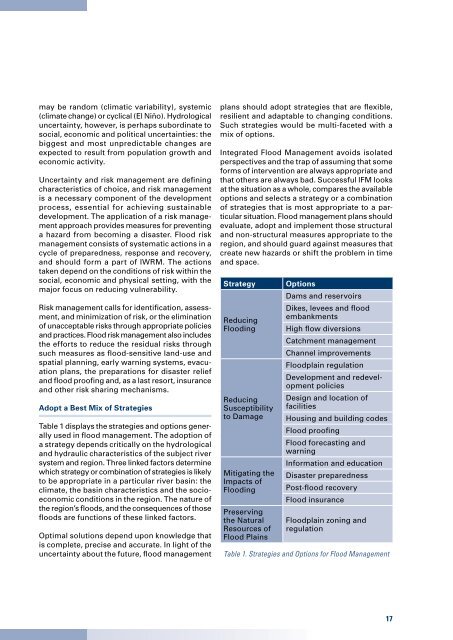Integrated Flood Management-Concept Paper.pdf - APFM
Integrated Flood Management-Concept Paper.pdf - APFM
Integrated Flood Management-Concept Paper.pdf - APFM
You also want an ePaper? Increase the reach of your titles
YUMPU automatically turns print PDFs into web optimized ePapers that Google loves.
may be random (climatic variability), systemic<br />
(climate change) or cyclical (El Niño). Hydrological<br />
uncertainty, however, is perhaps subordinate to<br />
social, economic and political uncertainties: the<br />
biggest and most unpredictable changes are<br />
expected to result from population growth and<br />
economic activity.<br />
Uncertainty and risk management are defining<br />
characteristics of choice, and risk management<br />
is a necessary component of the development<br />
process, essential for achieving sustainable<br />
development. The application of a risk management<br />
approach provides measures for preventing<br />
a hazard from becoming a disaster. <strong>Flood</strong> risk<br />
management consists of systematic actions in a<br />
cycle of preparedness, response and recovery,<br />
and should form a part of IWRM. The actions<br />
taken depend on the conditions of risk within the<br />
social, economic and physical setting, with the<br />
major focus on reducing vulnerability.<br />
Risk management calls for identification, assessment,<br />
and minimization of risk, or the elimination<br />
of unacceptable risks through appropriate policies<br />
and practices. <strong>Flood</strong> risk management also includes<br />
the efforts to reduce the residual risks through<br />
such measures as flood-sensitive land-use and<br />
spatial planning, early warning systems, evacuation<br />
plans, the preparations for disaster relief<br />
and flood proofing and, as a last resort, insurance<br />
and other risk sharing mechanisms.<br />
Adopt a Best Mix of Strategies<br />
Table 1 displays the strategies and options generally<br />
used in flood management. The adoption of<br />
a strategy depends critically on the hydrological<br />
and hydraulic characteristics of the subject river<br />
system and region. Three linked factors determine<br />
which strategy or combination of strategies is likely<br />
to be appropriate in a particular river basin: the<br />
climate, the basin characteristics and the socioeconomic<br />
conditions in the region. The nature of<br />
the region’s floods, and the consequences of those<br />
floods are functions of these linked factors.<br />
Optimal solutions depend upon knowledge that<br />
is complete, precise and accurate. In light of the<br />
uncertainty about the future, flood management<br />
plans should adopt strategies that are flexible,<br />
resilient and adaptable to changing conditions.<br />
Such strategies would be multi-faceted with a<br />
mix of options.<br />
<strong>Integrated</strong> <strong>Flood</strong> <strong>Management</strong> avoids isolated<br />
perspectives and the trap of assuming that some<br />
forms of intervention are always appropriate and<br />
that others are always bad. Successful IFM looks<br />
at the situation as a whole, compares the available<br />
options and selects a strategy or a combination<br />
of strategies that is most appropriate to a particular<br />
situation. <strong>Flood</strong> management plans should<br />
evaluate, adopt and implement those structural<br />
and non-structural measures appropriate to the<br />
region, and should guard against measures that<br />
create new hazards or shift the problem in time<br />
and space.<br />
Strategy<br />
Reducing<br />
<strong>Flood</strong>ing<br />
Reducing<br />
Susceptibility<br />
to Damage<br />
Mitigating the<br />
Impacts of<br />
<strong>Flood</strong>ing<br />
Preserving<br />
the Natural<br />
Resources of<br />
<strong>Flood</strong> Plains<br />
Options<br />
Dams and reservoirs<br />
Dikes, levees and flood<br />
embankments<br />
High flow diversions<br />
Catchment management<br />
Channel improvements<br />
<strong>Flood</strong>plain regulation<br />
Development and redevelopment<br />
policies<br />
Design and location of<br />
facilities<br />
Housing and building codes<br />
<strong>Flood</strong> proofing<br />
<strong>Flood</strong> forecasting and<br />
warning<br />
Information and education<br />
Disaster preparedness<br />
Post-flood recovery<br />
<strong>Flood</strong> insurance<br />
<strong>Flood</strong>plain zoning and<br />
regulation<br />
Table 1. Strategies and Options for <strong>Flood</strong> <strong>Management</strong><br />
17
















